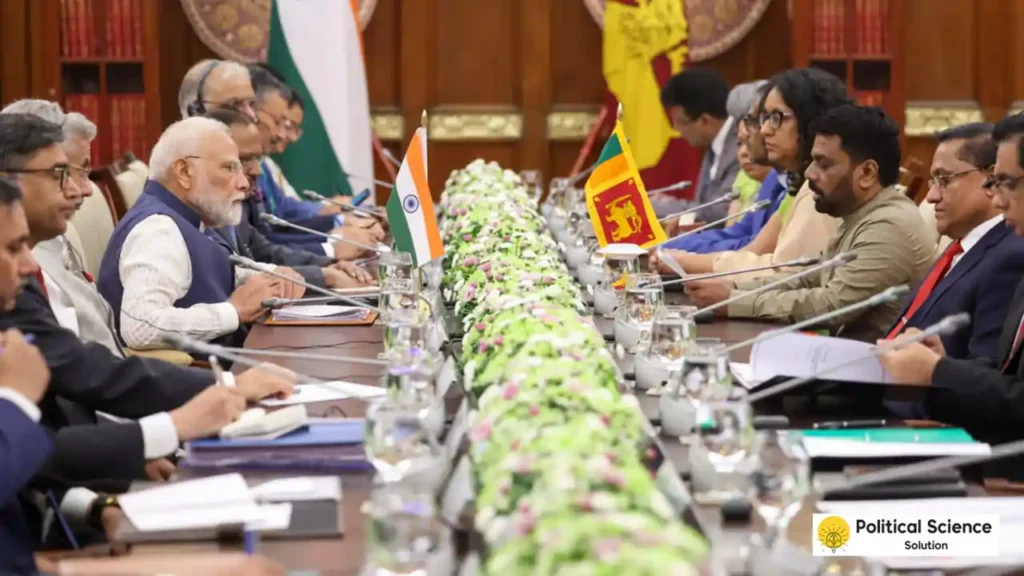New Delhi: In a landmark diplomatic engagement, Indian Prime Minister Narendra Modi concluded a three-day visit to Sri Lanka, strengthening bilateral ties through the signing of 10 pivotal agreements spanning defence, energy, digital infrastructure, health, and trade. The visit, Modi’s first since Sri Lankan President Anura Kumara Dissanayake assumed office in September 2024, underscored a shared commitment to regional stability and economic recovery amid growing geopolitical concerns in the Indian Ocean region. With China’s influence looming large, the agreements signal a robust counterbalance and a renewed focus on India’s “Neighbourhood First” policy and MAHASAGAR vision.

A Warm Welcome and Historic Honour
PM Modi arrived in Colombo on April 4, 2025, fresh from a Bimstec summit in Bangkok, and was greeted with a ceremonial welcome. The visit marked a significant milestone as Modi became the first foreign leader hosted by President Dissanayake since his election. Adding to the occasion’s prestige, Modi was conferred with Sri Lanka’s highest civilian honour for foreign leaders, the “Mitra Vibhushana” award, symbolizing the deep trust and friendship between the two nations. In his acceptance remarks, Modi emphasized Sri Lanka’s “special place” in India’s foreign policy framework, highlighting the cultural and strategic bonds dating back centuries.
Key Agreements: A Blueprint for Collaboration
The centrepiece of the visit was the signing of 10 Memoranda of Understanding (MoUs), each designed to deepen cooperation and address contemporary challenges. Here’s a detailed breakdown of the agreements:
- HVDC Interconnection for Power Trade: This MoU paves the way for a high-voltage direct current (HVDC) grid connection between India and Sri Lanka, enabling seamless import and export of electricity. It promises to bolster energy security and support Sri Lanka’s transition to sustainable power sources.
- Digital Transformation Partnership: Signed between India’s Ministry of Electronics and Information Technology and Sri Lanka’s Ministry of Digital Economy, this agreement focuses on sharing India’s expertise in scalable digital solutions, such as Aadhaar and UPI, to drive Sri Lanka’s digital economy.
- Trincomalee Energy Hub: A tripartite MoU involving India, Sri Lanka, and the United Arab Emirates aims to transform Trincomalee into a regional energy hub. Plans include a multi-product energy pipeline, enhancing energy infrastructure and trade.
- Defence Cooperation Framework: A first-of-its-kind agreement, this MoU institutionalizes joint military exercises, training programs, and high-level exchanges, reinforcing security collaboration amid regional tensions.
- Eastern Province Development: India pledged multi-sectoral grant assistance to uplift Sri Lanka’s Eastern Province, focusing on social and economic development projects.
- Health and Medicine Collaboration: This MoU between India’s Ministry of Health and Family Welfare and Sri Lanka’s Ministry of Health and Mass Media aims to enhance healthcare infrastructure and medical research.
- Pharmacopoeial Cooperation: Signed between the Indian Pharmacopoeia Commission and Sri Lanka’s National Medicines Regulatory Authority, this agreement ensures quality standards in pharmaceuticals and fosters bilateral trade in medicines.
- Railway Upgrades: Projects include the inauguration of the upgraded Maho-Omanthai railway track and the launch of a signalling system for the Maho-Anuradhapura line, boosting connectivity.
- Sampur Solar Power Project: A virtual groundbreaking ceremony marked the start of this Indian-supported solar initiative, set to generate clean energy for Sri Lanka.
- Debt Restructuring: Bilateral amendatory agreements were concluded, reducing interest rates on loans and converting $100 million worth of loans into grants, offering immediate financial relief to Sri Lanka.
Strategic Reassurances Amid Regional Dynamics
A key highlight of the visit was President Dissanayake’s unequivocal assurance that Sri Lanka would not permit its territory to be used against India’s security interests. This pledge, reiterated from his December 2024 visit to New Delhi, addresses India’s concerns over China’s expanding footprint, notably through the 99-year lease of Hambantota Port under the Belt and Road Initiative. In response, PM Modi expressed gratitude for Dissanayake’s sensitivity, noting, “We welcome the important agreement concluded in defence cooperation, and we will work together on the Colombo Security Conclave.”
The defence MoU, coupled with Sri Lanka’s commitment, strengthens India’s maritime domain awareness under the MAHASAGAR (Mutual and Holistic Advancement for Security and Growth Across Regions) vision, aimed at curbing illegal activities and enhancing ties with smaller regional states.
Economic Support and Recovery Initiatives
Sri Lanka’s economic crisis of 2022, which saw inflation soar and foreign reserves dwindle, remains a critical backdrop to this visit. India, having extended over $4 billion in aid during the downturn, reaffirmed its role as a steadfast partner. Modi announced a comprehensive capacity-building program for 700 Sri Lankans annually, alongside a support package of 2.4 billion Sri Lankan rupees for the Eastern Province. Additionally, a $17 million credit line will fund solar rooftop systems for 5,000 religious institutions, generating 25 MW of green power and benefiting Hindu, Buddhist, Christian, and Muslim communities.
Dissanayake lauded India’s support, stating, “The assistance extended in times of need is deeply cherished. Our debt restructuring program is on track, and India’s cooperation has been invaluable.” The leaders also virtually inaugurated a temperature-controlled agricultural warehouse in Dambulla, enhancing food security and rural livelihoods.
Cultural Ties and Symbolic Gestures
The visit wasn’t solely about geopolitics and economics; it celebrated the ancient cultural bonds between the two nations. On April 7, Modi will visit Anuradhapura’s Jaya Shri Mахаbodhi Temple, where the sacred Bodhi tree—believed to have grown from a sapling brought by Emperor Ashoka’s daughter Sangamitta in the 3rd century BCE—stands as a testament to shared heritage. He will unveil a platform plaque and flag off a train at Anuradhapura railway station, further symbolizing connectivity.
India also announced grant assistance for the restoration of the Thirukoneswaram Temple in Trincomalee, the Seetha Eliya Temple in Nuwara Eliya, and the Sacred City Complex in Anuradhapura. A special exposition of Lord Buddha’s relics from Gujarat is planned for International Vesak Day 2025, reinforcing spiritual ties.
Challenges in the Bilateral Relationship
Despite the positive momentum, challenges persist. China’s strategic encirclement via infrastructure projects like Hambantota Port remains a thorn in India’s side. The Tamil ethnic issue, with slow progress on the 13th Amendment’s implementation, continues to influence India’s domestic politics, particularly in Tamil Nadu. Maritime disputes, including incidents of firing on Indian fishermen and the unresolved Katchatheevu Island issue, also demand attention.
Modi’s Vision for the Future
In a tweet following the agreements, Modi wrote, “Key agreements have been signed between India and Sri Lanka, adding vigour to our friendship. Important projects were inaugurated, which will benefit countless people. India will always support Sri Lanka in its development trajectory.” His remarks encapsulate the visit’s dual focus: immediate support and long-term partnership.
The virtual launch of the Sampur Solar Power Project and the supply of solar systems to religious institutions underscore India’s commitment to sustainable development. Meanwhile, railway upgrades and digital collaboration signal a modernized partnership poised to meet 21st-century challenges.
Why This Visit Matters for India and Sri Lanka
For India, Sri Lanka’s proximity to key Indian Ocean shipping lanes makes it a linchpin in the MAHASAGAR vision and a counterweight to China’s regional ambitions. Economically, the 1998 Free Trade Agreement has propelled bilateral trade to $5.5 billion in 2023-24, with India’s exports at $4.1 billion. For Sri Lanka, India’s support is a lifeline as it navigates economic recovery and seeks to assert its sovereignty amid competing influences.
Looking Ahead
As Modi departs Colombo on April 7, the visit leaves an indelible mark on India-Sri Lanka relations. The 10 agreements, coupled with cultural and economic initiatives, lay a foundation for a resilient partnership. Yet, the success of this renewed alliance will hinge on addressing lingering challenges and maintaining momentum in a region fraught with geopolitical complexities.
For now, the message is clear: India and Sri Lanka are committed to “Fostering Partnerships for a Shared Future,” a vision that promises stability, growth, and mutual respect in an ever-evolving global landscape.

